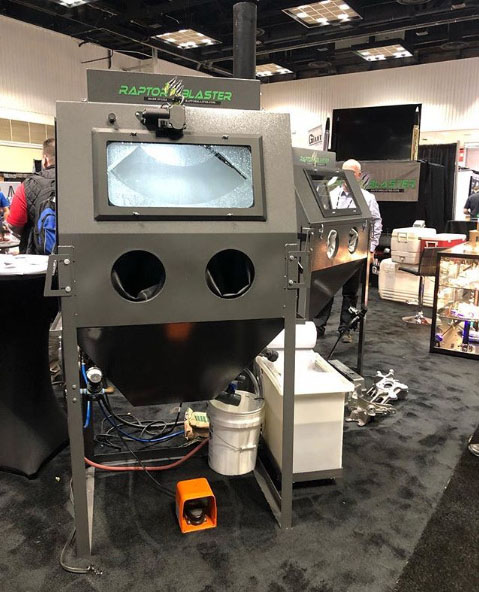
What’s the difference between a closed loop and and open loop wet blast cabinet?
We’ll look at what a closed loop system is, and how it might be advantageous in certain situations.
If you’re making a decision about which type of wet blast system is right for your facility, this article will help you weigh the pros and cons of each.
The main advantage of a closed loop wet blast system is it does not require a running water supply to operate. An open loop system is hooked up to an external water source (like a hose).
A closed loop wet blast cabinet only requires a compressed air supply and a power source to operate. Once you add abrasive and water to the cabinet, and add water to the external tank, you recycle the water-abrasive slurry mix until you want to change it out.
An example of a wet blast cabinet that has an optional closed loop system is our RB3630S Slurry Blast Cabinet.
When is a Closed Loop System a Good Choice?
Some production shops might need a closed loop wet blast system because running water is not available or practical in the shop. If it is inconvenient to run a hose to the wet blast cabinet, or if running water is unavailable, a closed loop system is a good choice.
Another reason a facility may want a closed loop system is because draining the blast cabinet may be impractical. If you are worried about waste water disposal, or properly disposing of spent abrasive, this may be another reason to add a closed loop to your wet blast cabinet.
How Does a Closed Loop Wet Blast Cabinet Work?
To get started, you must fill the sump about three-quarters full with a mixture of abrasive and water. A slurry pump pulls the mixture of water and abrasive to the blasting gun, where air is introduced at the nozzle, accelerating the abrasive, and providing the blasting force.
An external basin of water is hooked to the overflow valve. Extra water can be introduced to the blast cabinet by the window water knob, or by the rinse-off hose. This water is pulled from the external water basin.
The overflow valve is connected to the outside water basin. When the water level goes over the overflow, the water from the cabinet flows to the top of the external water basin. This overflow water passes over a metal tray with a paper filter, allowing particulates, dirt, grime, and spent abrasive to be filtered out from the circulated water. This leaves the water in the outside tank clean.
Spent abrasive and other particulates float to the top of the water, so these are easy to eliminate from the water supply with the filter in place. The unspent abrasive settles at the bottom of the hopper.
Whenever you use the rinse hose, water from the outside tank goes into the blast cabinet. The excess water goes from the overflow back into the external water tank, creating a closed loop.
The closed loop system reuses the water and slurry supply indefinitely, until you choose to drain the slurry mix from the cabinet.
If you are using an open loop system, you would hook up the fresh water supply to the water inlet on the back of the cabinet.
Should Your Shop Use a Closed Loop or Open Loop Wet Blast System?
A traditional open loop system is ideal if you have running water connections, and water disposal is not a concern.
Closed loop systems are the best choice if running water connections are impractical or limited, or if water disposal is inconvenient.
